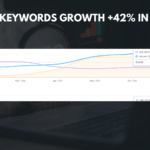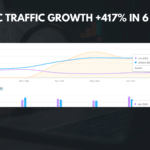
|
Getting your Trinity Audio player ready... |
In today’s digital age, website performance plays a crucial role in the success of any online business. A slow-loading website can lead to high bounce rates, decreased user engagement, and ultimately, lost revenue. On the other hand, a fast and efficient website can improve user experience, increase conversions, and boost search engine rankings.
To measure and enhance website performance, many businesses turn to tools like Google Analytics and Google Tag Manager. These powerful tools provide valuable insights into website traffic, user behavior, and conversion rates. By leveraging the data collected by these tools, businesses can make informed decisions to optimize their websites and improve overall performance.
Key Takeaways
- Website performance is crucial for online success
- Google Analytics provides valuable insights into website traffic and user behavior
- Google Tag Manager simplifies the process of adding tracking codes to a website
- Google Analytics measures website performance through metrics such as bounce rate and conversion rate
- Google Tag Manager enhances website performance by allowing for easy tracking of user interactions
Understanding Google Analytics: Features and Benefits
Google Analytics is a free web analytics tool provided by Google that allows businesses to track and analyze website traffic. It provides a wealth of information about how users interact with a website, including the number of visitors, their demographics, the pages they visit, and the actions they take.
One of the key features of Google Analytics is its ability to track conversions. Whether it’s a purchase, a form submission, or any other desired action on a website, Google Analytics can track and measure these conversions. This data is invaluable for businesses looking to optimize their websites for better conversion rates.
Another important feature of Google Analytics is its ability to provide real-time data. This means that businesses can see how users are interacting with their websites in real-time, allowing them to make immediate adjustments if necessary.
The benefits of using Google Analytics for website performance measurement and analysis are numerous. It provides businesses with valuable insights into their website’s performance, allowing them to identify areas for improvement and make data-driven decisions. By understanding how users are interacting with their websites, businesses can optimize their websites for better user experience and increased conversions.
Understanding Google Tag Manager: Features and Benefits
Google Tag Manager is another powerful tool provided by Google that allows businesses to manage and deploy website tags without the need for manual coding. Website tags are snippets of code that collect data and send it to third-party tools, such as Google Analytics.
One of the key features of Google Tag Manager is its simplicity and ease of use. It allows businesses to add, edit, and manage tags on their websites without the need for technical expertise. This means that businesses can quickly and easily implement tracking codes and make changes to their websites without relying on developers.
Another important feature of Google Tag Manager is its ability to streamline the tag management process. Instead of having multiple tags scattered throughout a website’s code, Google Tag Manager consolidates all the tags into a single container. This makes it easier to manage and update tags, reducing the risk of errors and improving website performance.
The benefits of using Google Tag Manager for website performance enhancement and optimization are significant. It allows businesses to easily implement tracking codes and make changes to their websites without relying on developers. This means that businesses can quickly respond to changes in user behavior and optimize their websites for better performance.
Key Differences between Google Analytics and Google Tag Manager
| Metrics | Google Analytics | Google Tag Manager |
|---|---|---|
| Functionality | Web analytics tool that tracks website traffic and user behavior | Tag management system that allows users to add and manage tracking tags on their website |
| Implementation | Requires installation of tracking code on website | Requires installation of container code on website and setup of tags within GTM interface |
| Customization | Offers limited customization options | Offers extensive customization options through the use of custom tags and variables |
| Tag Management | Does not offer tag management capabilities | Offers advanced tag management capabilities, allowing users to easily add, edit, and remove tags without the need for developer assistance |
| Integration | Integrates with other Google products such as Google Ads and Google Search Console | Integrates with other third-party tools and platforms, allowing for more comprehensive tracking and analysis |
While both Google Analytics and Google Tag Manager are powerful tools for measuring and enhancing website performance, they serve different purposes.
Google Analytics is primarily focused on tracking and analyzing website traffic, user behavior, and conversions. It provides businesses with valuable insights into how users are interacting with their websites, allowing them to make data-driven decisions to optimize their websites for better performance.
On the other hand, Google Tag Manager is focused on managing and deploying website tags. It allows businesses to add, edit, and manage tags on their websites without the need for manual coding. This streamlines the tag management process and makes it easier to implement tracking codes and make changes to websites.
While Google Analytics provides valuable data about website performance, Google Tag Manager is the tool that allows businesses to collect that data in the first place. By using Google Tag Manager to deploy tracking codes, businesses can ensure that they are collecting accurate and reliable data for analysis in Google Analytics.
How Google Analytics Measures Website Performance
Google Analytics uses a variety of metrics and reports to measure website performance. Some of the key metrics include:
- Traffic Sources: Google Analytics provides insights into where website traffic is coming from, whether it’s organic search, paid search, social media, or referrals. This information allows businesses to identify which channels are driving the most traffic and optimize their marketing efforts accordingly.
- User Behavior: Google Analytics tracks how users navigate through a website, including the pages they visit, the time they spend on each page, and the actions they take. This information allows businesses to understand how users are interacting with their websites and identify areas for improvement.
- Conversions: Google Analytics tracks and measures conversions, whether it’s a purchase, a form submission, or any other desired action on a website. This data allows businesses to understand their conversion rates and make data-driven decisions to optimize their websites for better performance.
By analyzing these metrics and reports, businesses can gain valuable insights into their website’s performance and make informed decisions to improve user experience and increase conversions.
How Google Tag Manager Enhances Website Performance
Google Tag Manager enhances website performance in several ways. Some of the key features and benefits include:
- Simplified Tag Management: Google Tag Manager allows businesses to manage and deploy website tags without the need for manual coding. This streamlines the tag management process and makes it easier to implement tracking codes and make changes to websites.
Improved Website Speed: By consolidating all tags into a single container, Google Tag Manager reduces the number of HTTP requests made by a website. This can significantly improve website speed and user experience.
Enhanced Website Functionality: Google Tag Manager allows businesses to add additional functionality to their websites through the use of tags. For example, businesses can use tags to implement A/B testing, personalization, and other advanced features.
By leveraging the features and benefits of Google Tag Manager, businesses can optimize their websites for better performance, improved speed, and enhanced functionality.
Best Practices for Using Google Analytics and Google Tag Manager Together
To get the most out of Google Analytics and Google Tag Manager, it’s important to follow best practices. Here are some tips:
- Set Up Goals and Funnels: Goals and funnels allow businesses to track specific actions and user journeys on their websites. By setting up goals and funnels in Google Analytics, businesses can gain valuable insights into how users are converting and identify areas for improvement.
Use Custom Dimensions and Metrics: Custom dimensions and metrics allow businesses to track additional data points that are not available out-of-the-box in Google Analytics. By using custom dimensions and metrics, businesses can gain deeper insights into user behavior and website performance.
Test and Validate Tags: Before deploying tags in Google Tag Manager, it’s important to test and validate them to ensure they are working correctly. This can be done using the built-in preview mode in Google Tag Manager or by using tools like Google Tag Assistant.
By following these best practices, businesses can ensure that they are collecting accurate and reliable data for analysis in Google Analytics and optimizing their websites for better performance.
Common Mistakes to Avoid when Using Google Analytics and Google Tag Manager
While Google Analytics and Google Tag Manager are powerful tools, there are some common mistakes that businesses should avoid. Here are a few:
- Not Setting Up Filters: Filters in Google Analytics allow businesses to exclude certain traffic from their reports, such as internal traffic or spam referrals. Not setting up filters can result in inaccurate data and skewed reports.
Overloading the Website with Tags: While tags are essential for collecting data, having too many tags can slow down a website and negatively impact user experience. It’s important to only include the necessary tags and regularly review and remove any unnecessary ones.
Not Regularly Monitoring and Analyzing Data: Collecting data is only the first step. It’s important to regularly monitor and analyze the data collected by Google Analytics and Google Tag Manager to identify trends, patterns, and areas for improvement.
By avoiding these common mistakes, businesses can ensure that they are getting accurate data and making informed decisions to optimize their websites for better performance.
Tips for Maximizing Website Performance with Google Analytics and Google Tag Manager
To maximize website performance with Google Analytics and Google Tag Manager, here are some additional tips:
- Optimize Website Speed: Use Google Tag Manager to implement tools like Google PageSpeed Insights to identify and fix issues that may be slowing down your website. A faster website can improve user experience and increase conversions.
Track User Engagement: Use Google Analytics to track user engagement metrics like time on page, bounce rate, and exit rate. This data can provide insights into how users are interacting with your website and help you identify areas for improvement.
Implement Conversion Tracking: Use Google Tag Manager to implement conversion tracking codes on your website. This will allow you to track and measure conversions, whether it’s a purchase, a form submission, or any other desired action.
By implementing these tips, businesses can leverage the power of Google Analytics and Google Tag Manager to optimize their websites for better performance, increased user engagement, and higher conversion rates.
Leveraging the Power of Google Analytics and Google Tag Manager for Optimal Website Performance
In conclusion, website performance is crucial in today’s digital age, and tools like Google Analytics and Google Tag Manager play a vital role in measuring and enhancing that performance. By using these tools together, businesses can gain valuable insights into their website’s performance, make data-driven decisions, and optimize their websites for better user experience and increased conversions.
Google Analytics provides businesses with valuable data about website traffic, user behavior, and conversions. By analyzing this data, businesses can identify areas for improvement and make informed decisions to optimize their websites.
Google Tag Manager, on the other hand, allows businesses to manage and deploy website tags without the need for manual coding. This streamlines the tag management process and makes it easier to implement tracking codes and make changes to websites.
By leveraging the power of Google Analytics and Google Tag Manager, businesses can maximize their website performance, improve user experience, and increase conversions. So, if you haven’t already, it’s time to start using these tools to measure and enhance your website performance.
If you’re interested in learning more about web development and how it relates to Google Analytics and Google Tag Manager, you should check out this informative article on mediaofficers.com. It delves into the importance of these tools in optimizing website performance and tracking user behavior. Additionally, if you’re looking to enhance your social media marketing strategies, you might find this article on mediaofficers.com helpful. And for those interested in drop servicing, there’s a comprehensive guide available on mediaofficers.com that explores the ins and outs of this business model.
FAQs
What is Google Analytics?
Google Analytics is a web analytics service offered by Google that tracks and reports website traffic. It provides insights into user behavior, demographics, and other important metrics that help website owners make informed decisions about their online presence.
What is Google Tag Manager?
Google Tag Manager is a tag management system that allows website owners to easily add and manage tags on their website without having to modify the code. It simplifies the process of adding tracking codes, conversion tracking, and other marketing tags to a website.
What is the difference between Google Analytics and Google Tag Manager?
Google Analytics is a web analytics service that tracks and reports website traffic, while Google Tag Manager is a tag management system that simplifies the process of adding tracking codes and other marketing tags to a website. In other words, Google Analytics provides insights into user behavior, while Google Tag Manager helps website owners manage the tags that track that behavior.
Do I need both Google Analytics and Google Tag Manager?
While it is not necessary to use both Google Analytics and Google Tag Manager, they can work together to provide a more comprehensive view of website traffic and user behavior. Google Tag Manager can simplify the process of adding tracking codes to a website, while Google Analytics can provide insights into user behavior and other important metrics.
Which one should I use, Google Analytics or Google Tag Manager?
It depends on your needs and goals. If you want to track website traffic and user behavior, Google Analytics is the better choice. If you want to simplify the process of adding tracking codes and other marketing tags to your website, Google Tag Manager is the better choice. However, using both together can provide a more comprehensive view of website traffic and user behavior.























































